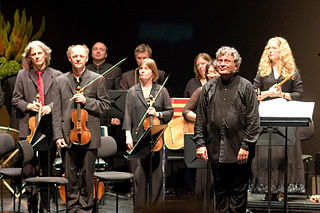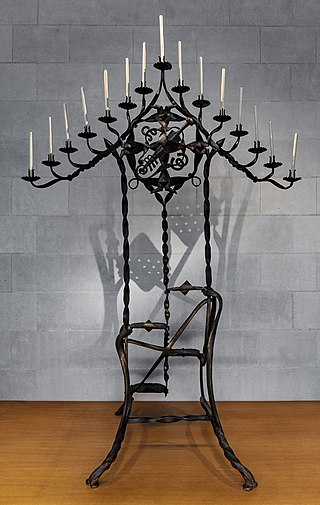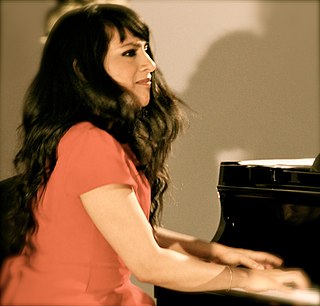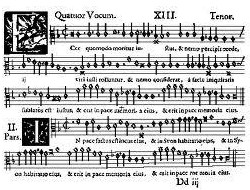Related Research Articles

René Jacobs is a Belgian musician. He came to fame as a countertenor, but later in his career he became known as a conductor of baroque and classical opera.

Tenebrae is a religious service of Western Christianity held during the three days preceding Easter Day, and characterized by gradual extinguishing of candles, and by a "strepitus" or "loud noise" taking place in total darkness near the end of the service.

The Tallis Scholars is a British professional early music vocal ensemble normally consisting of two singers per part, with a core group of ten singers. They specialise in performing a cappella sacred vocal music.
The year 1690 in music involved some significant events.
Gérard Lesne is a French countertenor. He is also the founder and artistic director of the baroque music ensemble, Il Seminario Musicale.

Le Poème Harmonique is a musical ensemble founded in 1998 by Vincent Dumestre to recreate and promote early music, in particular that of the 17th century. Using rare instruments such as the theorbo, the lirone, the tiorbino and the arpa tripla, Le Poème Harmonique aims to recapture the poetry of early music, particularly of the late renaissance and early baroque era. The early 17th-century French and Italian madrigal is a special interest. Le Poème Harmonique also teaches singers in collaboration with the Centre de Musique Baroque at Versailles. The group's recordings with the French Alpha record label of Jean-Paul Combet contributed to the critical and commercial establishment of the label, and included the 1st and 100th releases of the label's primary 'Ut Pictura Musica' series.
Noémi Rime is a French soprano. She regularly appears in opera productions by William Christie's Les Arts Florissants ensemble. Her roles have included Cleone in Médée, Dido in Dido and Aeneas, and Fatime in Les Indes galantes. She currently teaches on the faculty of the Conservatoire à rayonnement régional de Poitiers.

Les Arts Florissants is a Baroque musical ensemble in residence at the Théâtre de Caen in Caen, France. The organization was founded by conductor William Christie in 1979. The ensemble derives its name from the 1685 opera Les Arts florissants by Marc-Antoine Charpentier. The organization consists of a chamber orchestra of period instruments and a small vocal ensemble. Current notable members include soprano Danielle de Niese and tenor Paul Agnew, who has served as assistant conductor since 2007. Jonathan Cohen is also on the conducting staff; Christie remains the organization's Artistic Director.
The Leçons de ténèbres à une et à deux voix are a series of three vocal pieces composed in 1714 by François Couperin for the Abbaye royale de Longchamp.
Agnès Mellon is a French soprano who specializes in baroque music.

Shani Diluka is a Monegasque pianist of Sri Lankan descent. She was among those to benefit from a programme initiated by Princess Grace of Monaco, which allowed children to receive music lessons integrated into their schooling. She received the first prize in the Académie de Musique. She subsequently studied with Odile Poisson, a pupil of Pierre Sancan. Enrolled in the Conservatoire de Paris in 1997, she studied with Georges Pludermacher and François-Frédéric Guy and later with Marie-Françoise Bucquet, Nicholas Angelich and Bruno Rigutto.
The Ensemble Clément Janequin is a French early music ensemble founded in 1978 and specializing in the chansons of the Renaissance and early Baroque.
Leçons de ténèbres is a genre of French Baroque music which developed from the polyphonic lamentations settings for the tenebrae service of Renaissance composers such as Sermisy, Gesualdo, Brumel, Tallis, and Tomás Luis de Victoria into virtuoso solo chamber music.
Judith Anne Nelson, née Manes was an American soprano, noted for her performances of baroque music at the beginning of the "early music revival" of the 1970s and 1980s.
Sébastien Daucé is a French conductor, born in Rennes (France) on 4 June 1980. He is artistic director and founder of Ensemble Correspondances, formed from alumni of the Conservatoire National Supérieur de Musique de Lyon.
Tenebrae responsories are the responsories sung following the lessons of Tenebrae, the Matins services of the last three days of Holy Week: Maundy Thursday, Good Friday and Holy Saturday. Polyphonic settings to replace plainchant have been published under a various titles, including Responsoria pro hebdomada sancta.

The righteous perishes are the words with which the 57th chapter of the Book of Isaiah start. In Christianity, Isaiah 57:1–2 is associated with the death of Christ, leading to liturgical use of the text at Tenebrae: the 24th responsory for Holy Week, "Ecce quomodo moritur justus", is based on this text. More generally, the text is associated with the death of loved ones and is used at burials. As such, and in other versions and translations, the Bible excerpt has been set to music.
Concerto Vocale is a Belgian musical ensemble for baroque music.

Isabelle Druet is a French operatic coloratura mezzo-soprano who has performed internationally. She began her career as an actress and co-founded a theatre company, La Carotte. She has performed in concert and recorded with the ensemble Le Poème Harmonique. On stage, she has performed at opera houses in Paris, Nancy, Lyon and Düsseldorf, among others.

Claire Lefilliâtre is a contemporary French soprano specialising in Baroque music repertoire.
References
- ↑ Paul Doe and David Allinson. "Tallis, Thomas." Grove Music Online. Oxford Music Online. Oxford University Press. Web. 18 Jul. 2014.
- ↑ "Chamber Music". 24 May 2015. Retrieved 2019-06-12.
- ↑ "20776". Archived from the original on 2015-05-26. Retrieved 2015-04-26.
- ↑ Matthew Hunter